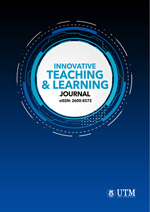Strategi Pengajaran Dan Pembelajaran Bahasa Melayu Kepada Penutur Asing: Pendekatan Teknologi (Apps) Dan Program Pengukuhan Berdasarkan Model Kolb
Keywords:
Teaching and Learning, Malay language, Technology, International Students, Foreign SpeakersAbstract
Teaching and learning strategies in the Malay language proficiency is required by the instructors include lexical elements, writing, speech, language and culture correlate, the application of technology that greatly influenced the interest of foreign students (Zeckqualine Melai et al. 2020). This study is a sequence from the study of Juwairiah Osman et al. (2018) demonstrated the use of Model Kolb in helping control the Malay language to international students. However, the weaknesses identified were the lack of comprehensive application in terms of technology -assisted activities and more relevant activities in terms of activities and strengthening programs. Accordingly, the Malay language learning strategy requires a systematic approach to learning, engaging, interactive and effective international students. This study aims to examine teaching and learning strategies based on the learning style of Kolb's Model (1984), namely reflective observation, abstract conceptual, effective experiment and concrete experience applied by international students at Universiti Malaysia Pahang. These four styles encompass a variety of traditional methods, learning innovations and technology-assisted approaches. This study involved a total of 30 international students, including foreign speakers who were at the Gambang Campus, Pahang. However, this study will focus on the application of the four learning styles of the Kolb’s Model including the construction of new applications (apps) produced in 2020, activities in the classroom, outside the classroom, online learning medium, public speaking programs and several other programs. Findings show that reflective observation approach in general is 11.11%, abstract conceptual is 11.11%, 33.33%and 66.67%, effective experiment is 11.11%while the final stage of concrete experience is 11.11%, 22.22%and 77.78%. The results show that the strategy can help mastering the Malay language to international students or foreign speakers at once attracted to studying the Malay language.
ABSTRAK
Strategi pengajaran dan pembelajaran bahasa Melayu dalam kemahiran berbahasa sangat diperlukan oleh tenaga pengajar termasuk elemen leksikal, penulisan, pertuturan, menghubungkait bahasa dan budaya, aplikasi teknologi yang amat mempengaruhi minat para pelajar asing (Zeckqualine Melai et al. 2020). Kajian ini merupakan rentetan daripada kajian Juwairiah Osman et al. (2018) yang telah menunjukkan penggunaan Model Kolb dalam membantu penguasaan bahasa Melayu kepada pelajar antarabangsa. Namun, kelemahan yang dikenal pasti ialah kurangnya aplikasi yang menyeluruh dari segi aktiviti berbantukan teknologi dan aktiviti yang lebih relevan dalam aspek aktiviti dan program pengukuhan. Sehubungan itu, strategi pembelajaran bahasa Melayu memerlukan pendekatan pembelajaran yang sistematik, menarik, interaktif dan berkesan kepada pelajar antarabangsa. Kajian ini bertujuan mengkaji strategi pengajaran dan pembelajaran berdasarkan stail pembelajaran Model Kolb (1984), iaitu pemerhatian reflektif, konseptual abstrak, eksperimen efektif dan pengalaman konkrit yang diaplikasikan oleh para pelajar antarabangsa di Universiti Malaysia Pahang. Keempat-empat stail ini merangkumi pelbagai kaedah secara tradisional, inovasi pembelajaran dan pendekatan berbantukan teknologi. Kajian ini melibatkan seramai 30 orang pelajar antarabangsa, iaitu termasuk penutur asing yang berada di kampus Gambang, Pahang. Namun, kajian ini akan berfokus pada aplikasi keempat-empat stail pembelajaran Model Kolb termasuklah pembinaan aplikasi (apps) yang baru dihasilkan pada tahun 2020, aktiviti dalam kelas, luar kelas, medium pembelajaran dalam talian, program pengucapan awam dan beberapa program yang lain. Dapatan menunjukkan pendekatan pemerhatian reflektif secara umumnya ialah 11.11%, konseptual abstrak ialah 11.11%, 33.33% dan 66.67%, eksperimen efektif ialah 11.11% manakala peringkat akhir iaitu pengalaman konkrit ialah 11.11%, 22.22% dan 77.78%. Hasil kajian menunjukkan strategi tersebut dapat membantu penguasaan bahasa Melayu kepada pelajar antarabangsa mahupun penutur asing sekali gus menarik minat untuk terus mempelajari bahasa Melayu.
Kata Kunci: Pengajaran dan Pembelajaran, Bahasa Melayu, Teknologi, Pelajar Antarabangsa, Penutur Asing
ABSTRACT
Teaching and learning strategies in the Malay language proficiency is required by the instructors include lexical elements, writing, speech, language and culture correlate, the application of technology that greatly influenced the interest of foreign students (Zeckqualine Melai et al. 2020). This study is a sequence from the study of Juwairiah Osman et al. (2018) demonstrated the use of Model Kolb in helping control the Malay language to international students. However, the weaknesses identified were the lack of comprehensive application in terms of technology -assisted activities and more relevant activities in terms of activities and strengthening programs. Accordingly, the Malay language learning strategy requires a systematic approach to learning, engaging, interactive and effective international students. This study aims to examine teaching and learning strategies based on the learning style of Kolb's Model (1984), namely reflective observation, abstract conceptual, effective experiment and concrete experience applied by international students at Universiti Malaysia Pahang. These four styles encompass a variety of traditional methods, learning innovations and technology-assisted approaches. This study involved a total of 30 international students, including foreign speakers who were at the Gambang Campus, Pahang. However, this study will focus on the application of the four learning styles of the Kolb’s Model including the construction of new applications (apps) produced in 2020, activities in the classroom, outside the classroom, online learning medium, public speaking programs and several other programs. Findings show that reflective observation approach in general is 11.11%, abstract conceptual is 11.11%, 33.33%and 66.67%, effective experiment is 11.11%while the final stage of concrete experience is 11.11%, 22.22%and 77.78%. The results show that the strategy can help mastering the Malay language to international students or foreign speakers at once attracted to studying the Malay language.
Keywords: Teaching and Learning, Malay language, Technology, International Students, Foreign Speakers
















